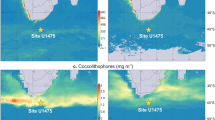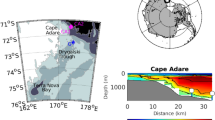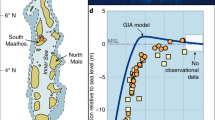Abstract
Hiatuses in the sedimentary record of the Southern Ocean are usually attributed to erosion by high-velocity bottom currents1–3. To test for palaeoclimatic mechanisms which intensified bottom circulation, however, the timing of increases in bottom-current velocity must be known. As the sedimentary record of the period of initial erosion is lost within the hiatus, the timing of increased velocity must be determined in cores which are adjacent to the axis of highest velocity4,5. In those cores the accumulation rates are reduced due to the current but a record of the period of initiation of scour is preserved as a zone of particle-size winnowing of the fine-fraction3–4. The timing of major episodes of bottom-current intensification in the South Australian Basin for the past 4.5 Myr are reported here for the first time and may be used to examine the role of palaeoclimatic fluctuations on bottom-current intensity.
This is a preview of subscription content, access via your institution
Access options
Subscribe to this journal
Receive 51 print issues and online access
$199.00 per year
only $3.90 per issue
Buy this article
- Purchase on Springer Link
- Instant access to full article PDF
Prices may be subject to local taxes which are calculated during checkout
Similar content being viewed by others
References
Watkins, N. D. & Kennett, J. P. Ant. Res. Ser. 19, 317–334 (1972).
Kennett, J. P. & Watkins, N. D. Bull. geol. Soc. Am. 87, 321–339 (1976).
Allison, E. T. & Ledbetter, M. T. Mar. Geol. (in the press).
Ledbetter, M. T., Williams, D. F. & Ellwood, B. B. Nature 272, 237–239 (1978).
Huang, T. C. & Watkins, N. D. Mar. Geol. 23, 113–132 (1977).
Corliss, B. Mar. Geol. 31, 115–118 (1979).
Muerdter, D. R., Dauphin, J. P. & Steele, G. J. sedim. Petrol. 51, 647–650 (1981).
Ledbetter, M. T. & Johnson, D. A. Science 194, 837–839 (1976).
Ledbetter, M. T. Mar. Geol. 33, 71–89 (1979).
Ellwood, B. B. & Ledbetter, M. T. Earth planet. Sci. Lett. 35, 189–198 (1977).
Keany, J., Ledbetter, M. T., Watkins, N. D. & Huang, T. C. Bull. geol. Soc. Am. 87, 873–882 (1976).
Ciesielski, P. F. & Weaver, F. M. Geology 2, 511–515 (1974).
Keany, J. Mar. Micropaleontol. 3, 35–49 (1978).
Shackleton, N. J. & Kennett, J. P. Init. Rep. DSDP Leg 29, 801–807 (1975).
Shackleton, N. J. & Opdyke, N. D. Nature 270, 216–219 (1977).
Ledbetter, M. T. & Huang, T. C. Mar. Geol. 36, M21–M28 (1980).
Weyl, P. K. Meteor. Monogr. 8, 37–62 (1968).
Osborn, N. I. thesis, Univ. Georgia (1981).
Author information
Authors and Affiliations
Rights and permissions
About this article
Cite this article
Ledbetter, M. Palaeooceanographic significance of bottom-current fluctuations in the Southern Ocean. Nature 294, 554–556 (1981). https://doi.org/10.1038/294554a0
Received:
Accepted:
Issue Date:
DOI: https://doi.org/10.1038/294554a0
Comments
By submitting a comment you agree to abide by our Terms and Community Guidelines. If you find something abusive or that does not comply with our terms or guidelines please flag it as inappropriate.



